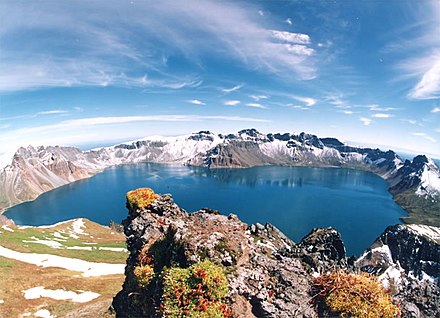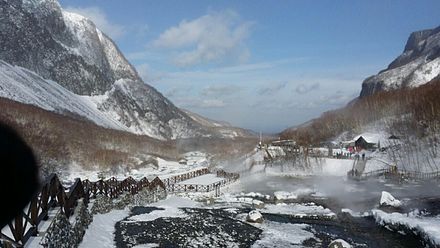Jilin - province of China
For other places with the same name, see Jilin (disambiguation).
Jilin (吉林, Jílín) Province forms the central part of northeast China and is part of what was once known as Manchuria. Jilin borders Heilongjiang Province to the northeast, Russia to the east, North Korea to the southeast, Liaoning to the southwest and Inner Mongolia to the northwest.

Cities
Jilin contains eight prefecture-level cities and one autonomous prefecture:
- Changchun (长春; Chángchūn) — subprovincial city and capital of Jilin Province.
- Baicheng (白城; Báichéng)
- Baishan (白山; Báishān)
- Jilin City (吉林; Jílín) — home of the Rimmed Trees of Jilin, one of the four major natural wonders of China.
- Liaoyuan (辽源; Liáoyuán)
- Siping (四平; Sìpíng)
- Songyuan (松原; Sōngyuán)
- Tonghua (通化; Tōnghuà)
- Yanji (延吉市; Yánjí) — in Yanbian, a Korean Autonomous Prefecture
Understand
Jilin province, which is in the central part of Northeast China, plays an important role in research on the origin of prehistoric jades and cultural exchange in this area. The name derives from the construction of Jilin Wu La City at the beginning of the Qing Dynasty (Ji for short), and the provincial capital is Changchun City. Jilin is a multi-ethnic province, including in addition to Han people important minorities of ethnic Koreans, Manchus, Mongols, Hui and Xibe people. The climate belongs to the warm temperate zone continental monsoon climate. The four seasons are distinct, with a hot rainy season that brings excellent greenery and suitable temperatures.
Talk
The Northeastern dialect of Mandarin is the most commonly spoken language in the province. Korean is spoken as a native language by the ethnic Korean minority, with a particularly high concentration of them in Yanji.
Get in
Jilin province has two public airports, Yanji Airport (IATA: YNJ) and Changchun Longjia International Airport (长春龙嘉国际机场) (IATA: CGQ). Each receives domestic flights as well as international flights from Seoul in South Korea. Changchun also has a route to Tokyo, Japan. Changchun City is 31 km, and Jilin City is 71 km from Changchun Longjia International Airport.
Get around
By taxi
Taxis are by far the best way to get around. They are cheap but you should have a piece of paper with the address in case you do not speak Mandarin. Taxi fares start at ¥5 up to 2.5 km (some cities will need to plus a mandatory ¥1 fuel surtax), after that ¥1.30/.5 km or ¥1/700 m. Several taxi companies are serving the city and they will not try to cheat you. It is common for drivers to pick up other passengers who might be going in the same direction if there are unused seats.
However, in case driver is taking you in circles - in this case complain for example at the hotel drop-off point. The staff there normally will support you in such cases. For other cases simply pay not more than shown on the meter. In general: Make sure you know the name of the places you are going to in Mandarin or have a paper with the Chinese address with you.
On foot
From April to October, it is a decent walking city, as the weather is fine. During the winter months temperatures are too cold to walk longer distances in Changchun, so other forms of transport should be considered.
By light rail
Changchun light rail (轻轨; qīngguǐ) Line 3 goes from the west side of the train station (长春站) to Changying Movie Wonderland (长影世纪城). It travels past Changchun University (长春大学) approximately half-way along the route, and takes 63 minutes to complete the entire journey. A ticket, purchased at any light rail station, costs ¥1-4 each way, based on the distance traveled. Operates 6AM-9PM daily.
A south-north route (Line 4) runs on Linhe Street. Its northern terminal is the New North Railroad Station and its southern terminal is the government center at CheChang.
Free transfer between Lines 3 and 4 can be had at the LinheJie (Line 3) and WeixingLu (Line 4) stations.
By bus
Bus system is cheap and convenient, and most of the buses in the urban area charge only ¥1 no matter where you go. An extensive bus network and most of the buses cost ¥1, however, those who can not read Chinese will find it nearly impossible to use the network.
By minibus
In Changchun and Yanji, if you are in need of an adrenaline rush, look no further than one of the minibuses that tear around the city streets. Some places out in the suburbs are only serviced by such buses, and the fare is usually ¥1-2.
By bicycle
Travelers should be cautious of bicycling. For the winter months it is generally too cold and during the summer months, too dangerous. Unlike other big cities in China, some cities like Changchun, Baicheng and so on do not separate cycle lanes from the main traffic, which leads to buses, taxis, cars, and motorcycles sharing the same space as the cyclists. The whole situation is dangerous and this is perhaps the reason why by Chinese standards there are few people who regularly cycle here.
If you want to bike around, it is recommended that you follow closely behind one of the local people on cargo-bike, merchant-bike, or donkey. There are off times during the day when biking would be less challenging. Drivers are not overly aggressive towards bikers.
By motorcycle
If you need to get somewhere fast then jump on one of these. It is used in the most cities. They are unlicensed to carry fare paying passengers, so bear in mind that if there is an accident, you might find yourself in trouble. However, they tend to drive in the cycle lanes at quite low speeds and so are safer than you might expect.
See
Landmarks and buildings




- Goguryeo Ancient sites, 41.125307°, 126.194031°. the remains of the ancient kingdom of Goguryeo. The Goguryeo are credited as the ancestors of the Korean people. These sites include including Wunu Mountain City, Guonei City and Wandu Mountain City; fourteen imperial tombs; twenty-six noble tombs; a General's Tomb; and the monument to the nineteenth Emperor of the Koguryo Kingdom, which are now UNESCO World Heritage Site. Most of these are around Ji'an.
- Puppet Emperor's Palace, 43.9058372°, 125.34842260000005°. The former residence of Puyi, the last emperor of China and the Puppet Emperor of Manchuco on behalf of the Japanese. In the north east of Changchun.
- Wen Miao Confucian Temple, 43.8921550000°, 125.3581700000°. In Jilin City. Together, Confucius Temple in Nanjing, Confucius Temple in Beijing and Confucian Temple in Qufu are called "Four Confucious'Temple of China". It is important national protective object. The size of the building group and high level are unique in the feudal society. Every building facility there are full of deep culture.
- Changbaishan, 42.003641845790504°, 128.05835723876953°. Changbaishan is 2749 m high and is on the border between China and North Korea. It's capped with snow all year round and has virtually no living vegetation on top. In Chinese, it's known as Changbaishan - "Chang" for always, "Bai" for white, and "Shan" for Mountain. Located in the counties of Antu, Wusong and Changbai in southern Jilin Province, Changbaishan is one of China's nature preservation zones, covering an area of over 200,000 hectares, extending 78.5 km north to south, and 53.3 km west to east. It has a wholesome natural environment and ecosystem with world famous precious animals like Northeast Tigers, sikas, sables etc. It's China's typical comprehensive nature existence of world importance.
Parks and nature
- Longtou Mountain, 44.0515860000°, 125.2066020000°. These hills contain ancient Tombs including the Mausoleum of Princess Zhenxiao and royal tombs of the Balhae kingdom. It is in Yanbian Korean Autonomous Prefecture.
- Rimmed Trees of Jilin, 44.8455300000°, 126.5396090000°. The trees are extolled as one of the four major natural wonders of China along with the Three Gorges of the Yangtze River, the landscape of Jilin and the Stone Forest of Yunnan.
Museums and exhibitions
- Meteorite Museum, 43.8348330000°, 126.5692280000°. In 1976, Jilin was hit by a heavy meteorite storm. Many of the stones were collected and placed into this museum. The largest stone weighs 1,775 kg and is thought to be the largest meteorite in existence.
- Jingyuetan National Scenic Area, 43.7883270000°, 125.4774670000°. It is one of the AAAAA class scenic spots of the first group in China. Jingyuetan national forest park in Changchun of Jilin Province is located in the eastern mountains to the western steppe transition zone, Changbai Mountain is a hilly are with peaks 119-406 m above sea level. The park is to the south-east of Changchun City, 9 km from the city center!
Do
- Jilin Ice Lantern Festival — not as famous as the festivals in Harbin but still worth a visit (during mid-January)
Eat
Drink
- Old Ship Bar (老船吧), Between Jingcheng Street and Anshun Road, 43.8557140000°, 125.2304730000°, +86 43188888099. Literally housed in a small wooden sailing ship. Serves beer and other beverages, has indoor barbecue features for seafood as well as other types of barbecue, Western flavors, a cheerful atmosphere and melodious music. 2016-12-13
- Mayflower Bar(五月花酒吧), Between Qinghua Road and Lixin Street, 43.8799340000°, 125.3267950000°, +86 43185679898. The beer here is very good and the music here is "very passionate". 2016-12-13